ECONOMICS :)
1/283
There's no tags or description
Looks like no tags are added yet.
Name | Mastery | Learn | Test | Matching | Spaced |
|---|
No study sessions yet.
284 Terms
What is Relative Scarcity?
The basic economics problem. Where we have an unlimited amount of needs and wants but only a limited amount of recourses available to fulfil them.
Hence decisions need to be made about how to allocate the scarce resources such that is maximizes living standards.
What are the consequences of not achieving Price Stability?
Erodes purchasing power
MLS/NMLS (basic necessities health)
Wage-price spiral
Distorting the allocation of recourses
Less internationally competitive
AD/Real GDP/ labour
Delay purchases
Unemployment (producers cannot keep decreasing wages and just fires people)
Returns on investment may be lower
What are the consequences of not achieving Full Employment?
MLS
NMLS
More homeless people, increased crime rates, social unrest, financial stress
Impact income taxes/ corporate taxes/ GST - gov collect less tax and pay out more benefits
Inflation
GDP
Erosion of purchasing power
Business Confidence
Business confidence measures the general level of optimism (or pessimism) about the future state of the economy (from a firm’s perspective).
The level of business confidence can be influenced by:
Expected rates of inflation
Consumer Confidence
Consumer confidence measures the general level of optimism (or pessimism) about the future state of the economy (from a consumer’s perspective), employment prospects and their future financial situation.
The level of consumer confidence can be affected by a range of sub-factors including (but not limited to)
How to structure the demand/supply curve long questions
Talk about the SHIFT
The demand curve has shifted to the left from D1 to D2 because of [xxx], resulting in a decrease in the quantity demanded at each and every price level, while supply has remained constant
Surplus/shortage
The Initial decrease in demand creates a surplus at the original price P1, where quantity supplied is greater than the quantity demand. This places a downwards pressure eon prices.
Signals to producers
As the price decreases, this sends signals to producer that production is not as profitable as it once was and to reallocate rouses into to other areas of production
As the price increase, suppliers become more w/a to produce g/s and thus reallocates their resources into the production of [x] because profit maximisation opportunities exist.
Supply/demand CONTRACTION
As a result, supply contracts (movement along the supply curve) as producer reallocate resources.
Demand expands as consumers are more w/a to purchase the product at the lower price (P3) (movement along the supply curve)
5. Adjusting
The market adjusts from equilibrium price P1 to a lower equilibrium price P3, with a decreased quantity of goods and services producer at Qty 3 as a result of [xxx]
What is the difference between production and productivity?
Production refers to the total output of goods and services produced in an economy
Productivity relates to the efficiency of the resources used in the production process, defined as output per unit of input (e.g. labour or capital productivity)
The difference is that you can increase production by using more inputs, but increasing productivity means to produce more output with the same level of input
What is the Balance of Trade?
The difference between the value of a country’s exports of goods and the value of its imports of goods over a period of time
Balance of Merchandise trade
Net goods + Net services sub-accounts
What is the Trade Weighted Index?
An index that measures the value of the AUD against a basket of trading partner currencies, weighted by the importance (share) of each partner in trade
Great indicator of competitiveness
Rise in TWI can help reduce inflation, but then becomes less competitive
What is the income effect
The income effect refers to how a change in the price of a good or service affects consumers’ real purchasing power, which then changes the quantity demanded of that good
What is the substitution effect?
Refers to how a change in the relative price of a good or service causes consumers to substitute away from relatively more expensive goods towards cheaper alternatives, changing the quantity demanded
What is the differences b/w the income and substitution effects?
Upon a price change:
The income effect changes what a consumer can buy with their income
The substitution effect happens changes what they prefer to buy
*Neither cause a shift in the demand curve
What are public goods?
Non-excludable
You can’t stop people from using it, even if they haven’t paid for it
Non-rivalrous
One person’s use does not reduce the amount available for others.(e.g. street lights, national defence, light houses)
What are Opportunity Costs?
The production/value of the second best option forgone when choosing the best option.
For example: By spending $70 billion on JobKeeper, the government is unable to inject that money into education which would create more skilled labour in future.
What are the 3 basic Economics Questions?
What and how much to produce
Businesses conduct research into the market to discover the demand for the specific g/s they wish to produce and the correct amount to produce to limit waste.
How to produce
This refers to the combination of labour and/or machinery which is used to produce the good or service.
For whom to produce for
Who is the target market? What do they want out of the product and how much are they willing to pay.
What does a PPF show
That shows all the different production possibilities of 2 goods than can be produces using all available resources of a nation.
Opportunity costs
Trade-offs
All points on/inside/outside the PPF are…
All points on the curve (D) demonstrate the country using their resources to their maximum potential
All points inside the curve (A) means that country is not using their resources to their maximum potential
All points outside the curve (X) means that a country is producing beyond their capacity which will be unsustainable in the long run.
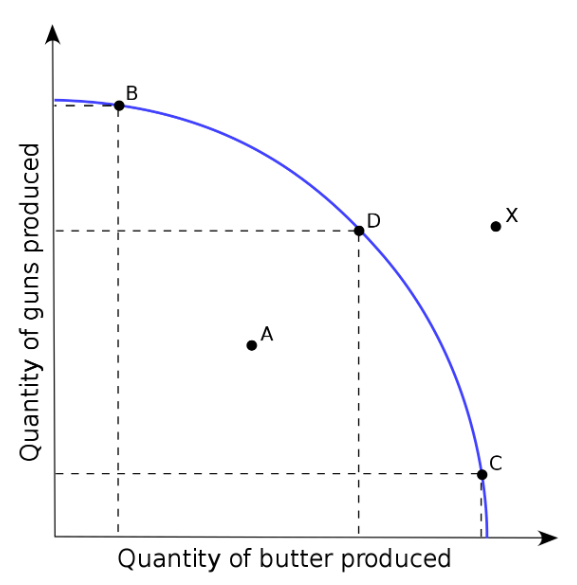
Opportunity Costs on the PPF
If we move from point X to point Y then the opportunity cost is 40 units of good A that are no longer being produced.
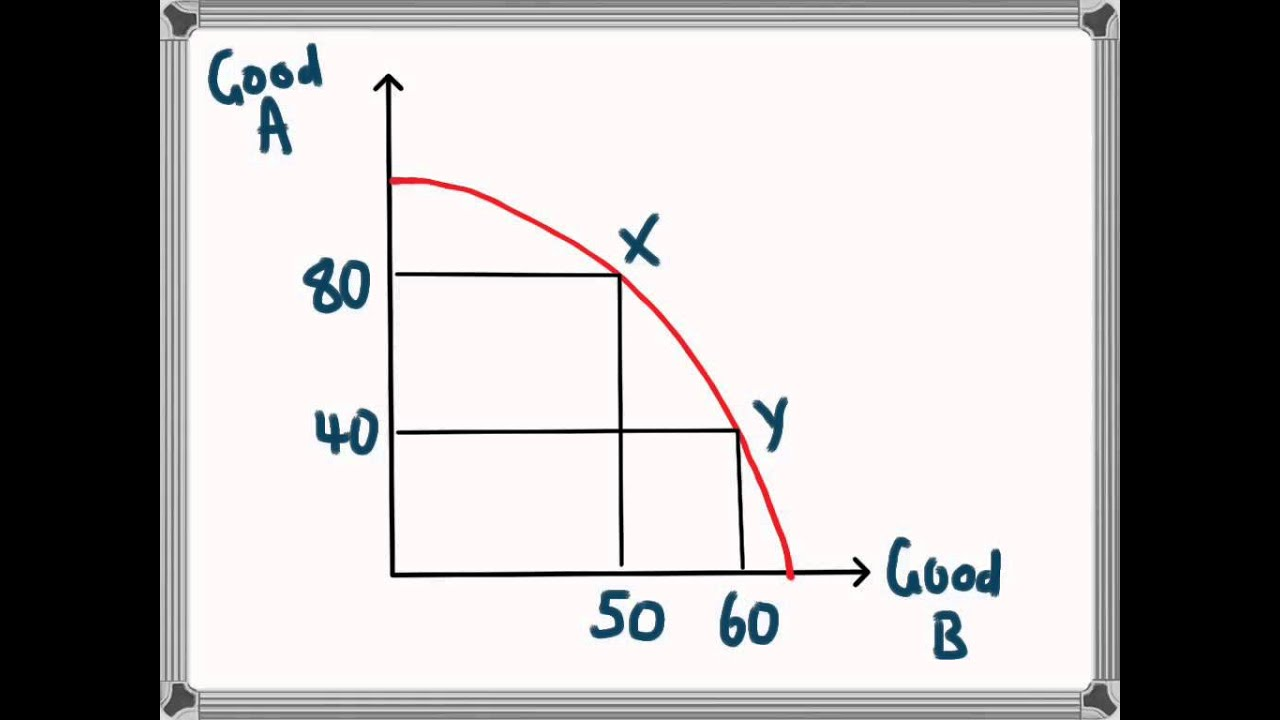
Trade Off on the PPF
If we move from point X to point Y then the trade of is 40 units of good A that are lost and the 20 units of good B that are gained.
*Need to include what is gained and what is lost
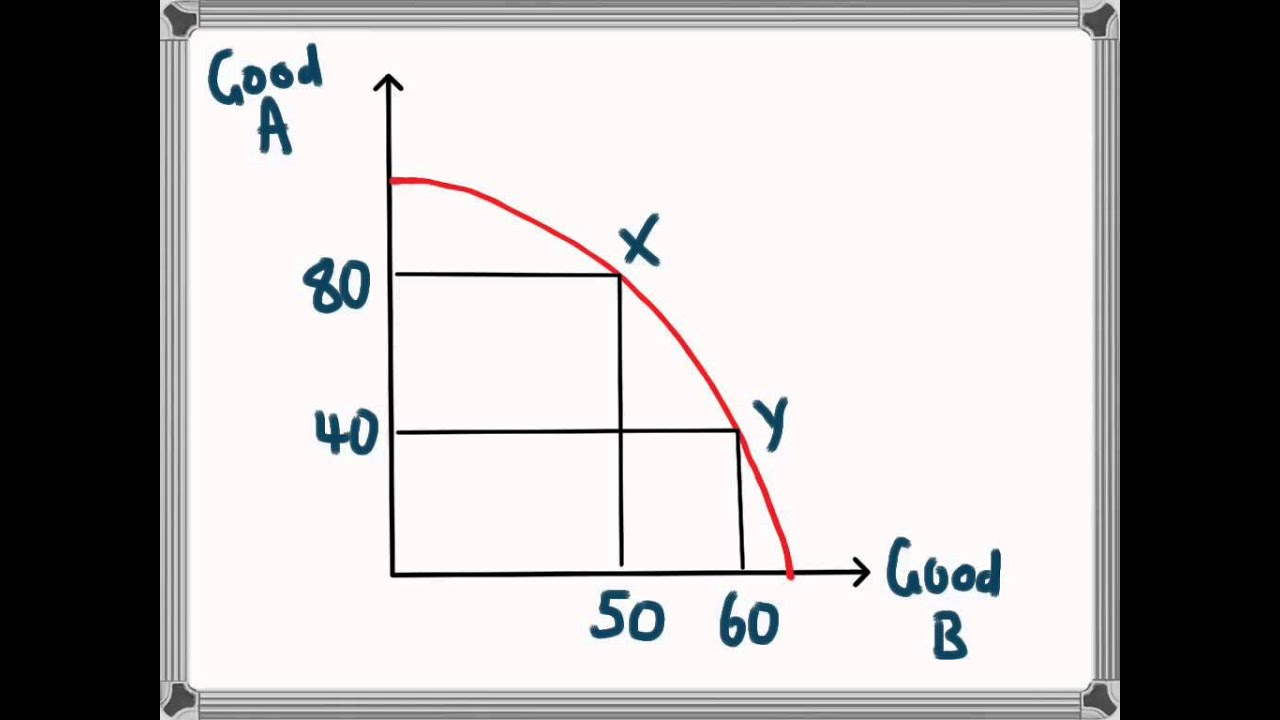
How can the PPF shift to the right or sustainably increase their production to point X
Education and training for workers (L)
Increased migration of skilled workers (L)
New technology being implemented (C)
Seek out new land and new natural resources (L)
What are some assumptions made about the PPF?
No international trade
All resources are used to only produce 2 g/s
Each unit of resource are worth the same
The economy has a fixed amount of land, labor and capital resources
Curve illustrates an economy’s possible production at a single point in time
What are the different types of Efficiency?
Allocative efficiency
Technical/ Productive efficiency
Dynamic efficiency
Intertemporal efficiency
Allocative efficiency
Occurs when the allocation of resources chosen to produce the goods and services maximize society’s wellbeing
Any point along the curve MAY be considered allocatively efficient as all resources are going towards maximising production. It comes down to the personal beliefs of those making decisions.
When asked a qs on where on the PPF it allocatively efficient
State all point can be, depends on the values and ethics of the consumers
Give a made up example
Technical Efficiency
Occurs when productivity is at a maximum and where average costs are at a minimum.
There may be one point where output is at a maximum (along the curve) in which case this would be the most technically efficient as the inputs have been used to produce the most output.
Dynamic Efficiency
Refers to how quickly (time) an economy can reallocate to achieve allocative efficiency. This means how fast a business can change production to match societies changing needs and wants.
On the PPF this would mean being able to quickly move from point B to point D if society suddenly wanted more butter.
Intertemporal Efficiency
The right balance of using resources between current and future generations so as to not undermine future generations ability oy meet their n/w.
On the PPF this means not producing at point X without increasing our capacity as that would be unsustainable for future generations
This is different from the other efficiencies as it considers the allocation of resources for the future
What is the Law of Demand?
As price increases, quantity demanded decreases
As price decreases, quantity demanded increases.
*if qs asks for this, define demand first which is the quantity of g/s that consumers are willing to purchase at a particular price during a specified time periods.
Contraction/Expansion along the Demand Curve?
NEED to refer to the reasons when discussing this
When selling prices increase and quantity demanded decreases we call this a contraction of demand.
When selling prices decrease and quantity demanded increases we call this an expansion of demand.
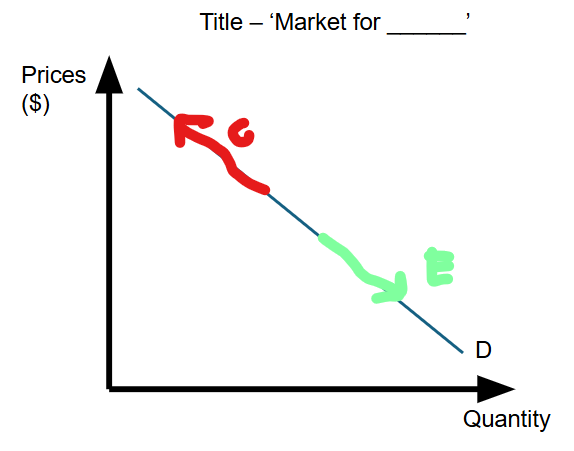
What causes shifts of the Demand Curve?
Changes to disposable income
Successful advertising
The change in price of a substitute item
The change in price of a complementary item
Decreases to personal income tax
Population demographics
Trends/ preferences
Interest rates
Consumer confidence
Business confidence
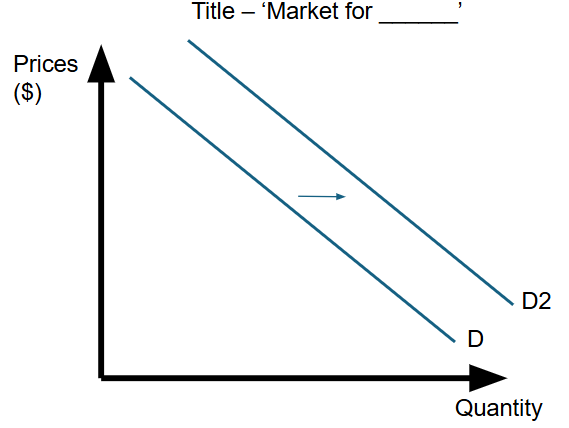
What is the Law of Supply?
As price increases, quantity supplied increases
As price decreases, quantity supplied decreases.
Define supply: The amount of a good that producers are willing and able to sell for a certain price during a specified time period.
What is the theory of supply?
Profit motive:
Firms aim to maximise profit.
Higher prices → higher potential revenue → incentive to produce more.
Costs of production:
Supply increases as price covers marginal costs of producing additional units.
At lower prices, producing more may be unprofitable
Contraction/Expansion along the Demand Curve?
When selling prices decrease and quantity supplied decreases we call this a contraction of supply.
When selling prices increase and quantity supplied increases we call this an expansion of supply.
What are some factors that shift the supply curve?
Changes to a business’ cost of production
E.g. cost of resources, electricity, rent, wages, subsidies.
Changes to the productivity/efficiency of a business
E.g. new technology, education and training for workers, research and development
Number of suppliers
Climatic conditions
What is Equilibriums?
The price where quantity supplied and demanded are equal, there is no shortage or surplus and the market is cleared.
What happens when the price is set above the equilibrium?
Supply exceeds demand.
This is known as a surplus, glut or oversupply.
Causing downwards pressure on price.
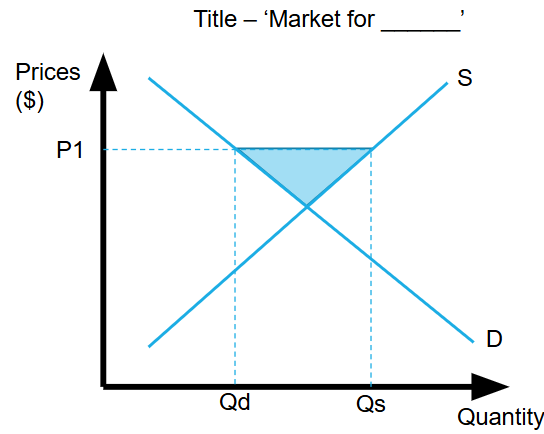
What happens when the price is set below the equilibrium?
Demand exceeds supply.
This is known as a shortage or undersupply.
Causing upwards pressure on price.
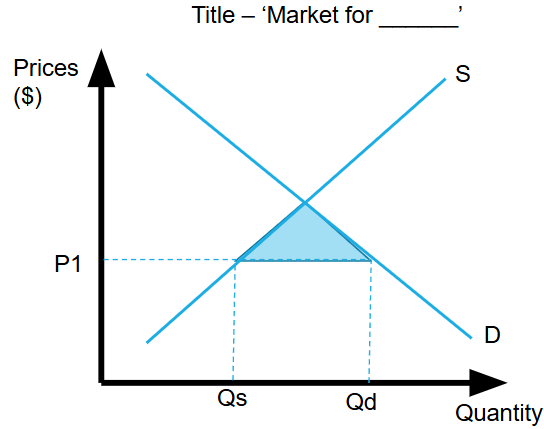
New equilibrium - shortage
When there is a favourable shift of demand, initially there is a higher quantity demanded at the same price.
This creates a shortage as suppliers are unwilling/unable to supply that amount and there is upwards pressure on prices until a new equilibrium is formed at a higher price.
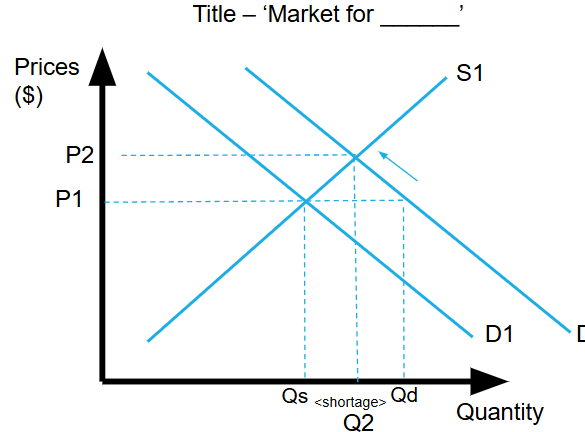
New equilibrium - surplus
When there is an unfavorable shift of demand, initially there is a lesser quantity demanded at the same price.
This creates a surplus as consumers are unwilling/unable to purchase that good or service at that price. This leads to suppliers decreasing prices to sell off excess stocks until a new equilibrium is formed.
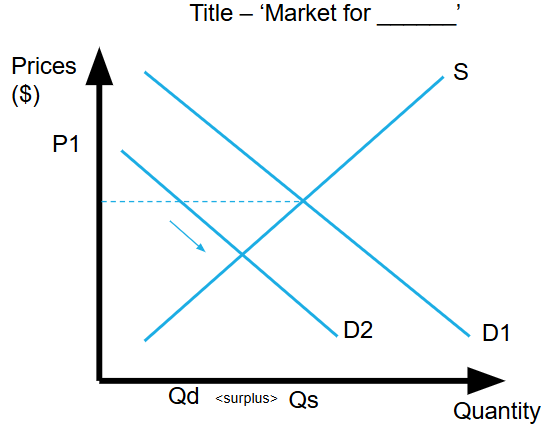
What does Price Elasticity of Demand do?
Measures the responsiveness of the quantity demanded for a g/s to a change in price of that g/s
PED= % change in quantity demanded/ % change in price
What is High/elastic PED?
Where a change in price will lead to a larger change in quantity demanded
E.g. If price decreases by 10%, quantity demanded increases by 20%
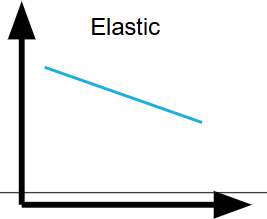
What is Low/inelastic PED?
Where a change in price will lead to a smaller change in quantity demanded
E.g. If price increases by 10%, quantity demanded decreases by 5%
*When price increases demand will go down, but by a smaller % than increase in price
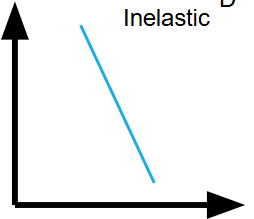
What factors Impact Elasticity of Demand?
Degree of necessity
necessities (e.g. water, electricity)= inelastic
luxuries = elastic
Addictions = Low PED
Availability of substitutes
no substitutes = inelastic
Proportion of income –
Take a large portion of income = elastic. G+S which cost very little (e.g. toothpicks) tend to be inelastic as even if they increase in price it will not make a large impact.
Time
Short-term consumers may not care about the increase in price but overtime if price keeps increasing consumers will seek other alternative.
If you need something now it’s inelastic, if you can wait it will be more elastic.
Time gives byers the opportunity to find alternatives and break habits.
What does Price Elasticity of Supply do?
Measures the responsiveness to the quantity supplied of a g/s to a change in the price of g/s
*Put on business caps, think if they CAN produce more…
What is High/elastic PED?
Where a change in price will lead to a larger change in quantity supplied
E.g. If price decreases by 10%, quantity supplied decreases by 20%
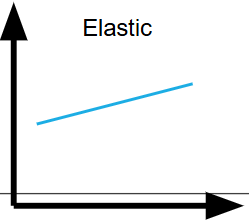
What is Low/inelastic PED?
Where a change in price will lead to a smaller change in quantity demanded
E.g. If price increases by 10%, quantity demanded increases by 5%
What factors affect the Elasticity of Supply?
Spare Capacity
Not using their resources to their maximum potential then supply tends to be more elastic (as they can respond to a change in price)
Are at capacity supply is more inelastic (as in the short term, they cannot increase production).
Production Period
Long Production Periods (e.g. fruit, veg ) inelastic —> supplied may not have enough time to adjust their production level in response to price changes
Short Production Periods (e.g. music) = elastic
Durability
Longer ‘shelf life’ = elastic as businesses are able to keep stock in storage and respond quickly to increases in price.
Perishable goods tend to be inelastic as there is a limited window which they can be sold for.
High PES means that cannot respond quickly to higher levels of demand, shortages persist longer → allowing producers to raise prices to higher lvls
How to Structure PED/PES questions?
Define PED/PES - “responsiveness”
Factor
State the factor and then explain in detail HOW it affect the consumers/ businesses
If qs asks to compare, then use 1 factor and state why one is higher/lower
Conclusion
“As PEDs decrease the…”
PARAGRAPH, PARAGRAPH, PARAGRAPHS
What conditions must exist for a Perfect Competition?
MANY BUYERS AND SELLERS
No individual have all the market power to influence price
Sellers are price takers (strong competition)
PRODUCTS ARE HOMOGENOUS (No product differentiation)
Encourages sellers to offer the lowest price possible
THERE IS EASE OF ENTRY AND EXIT
If demand for a g/s increases new firms can easily join and take advantage of the opportunity to make profit
What assumptions are made about a perfectly competitive market?
Buyers and sellers operate with full information and make rational choices.
Resources are mobile and will be reallocated to whatever is most beneficial.
The buyer and seller aim to maximise profits and maximise utility
How do competitive markets affect Allocative efficiency?
The competitive environment promotes allocative efficiency because suppliers pay close attention to price signals in order to meet the needs and wants of the consumers.
Through better use of resources and more efficient production techniques, the market promotes improvements in satisfaction (making someone better off), without making anyone else worse off.
How do competitive markets affect Technical efficiency?
Need to attract customers through offering the lowest prices
This means that by increasing productive efficiency, existing resources can achieve higher production volumes with lower input, thereby achieving higher levels of technical efficiency.
How do competitive markets affect dynamic efficiency?
The movement to the new set of equilibrium prices will happen relatively quickly
it relatively easy for firms to change their production processes and focus their efforts on the more profitable areas
This means increases in demand can be met, because new competitors will enter the market as the relative price of a product increases.
*Remember resources are mobile and there are low barriers of entry and exit
How do competitive markets affect Inter-temporal efficiency?
If there is excessive spending and not enough saving, the money market may experience a shortage of funds that are available for investment.
This shortage will therefore promote an increase in interest rates.
The higher interest rates will help to rebalance the level of spending in the economy, because the incentive to save will increase
What are Relative Prices?
The final price of a particular g/s relative to another.
Divide the desired sum but the other price from both years and see if that has increased or decreased
Changes in relative prices send clear signals to producers and consumers and therefore direct resources to their most profitable use.

How to structure a relative price qs about a supply-side factor?
1. Define relative price
2. Supply factor and the shift (e.g. carbon tax on coal)
3. Relative price up/down (coal price increases)
4. Quantity demanded (original market) contract/expands (demand for coal decreases)
5. Therefore demand for other substitute markets favourable/ unfavourable shift (demand for renewable energy increases due to lower relative price)
Need to state the non-price factor is a change in the price of substitutes.
6. Expansion/ Contraction of supply (substitute market) →Reallocation of resources (producers notice the higher price of solar panels, then allocate resources into the production of solar power)
How to structure a relative price qs about a demand-side factor?
1. Define relative price
2. Demand factor and the shift (e.g. solar panel rebates & interest-free loans)
3. Relative price up/ down (P1 to P2) (higher demand causes upward/downward pressure on price)
4. Quantity supplied (original market) contracts/ expands (market price increases, producers allocate resources into producing solar panels)
5. Therefore demand for the other substitute market favourable/ unfavourable shift (unfavourable shift in demand for coal)
Need to state the non-price factor is a change in the price of substitutes.
6. Expansion/ Contraction of supply (substitute market) →Reallocation of resources (producers notice the lower price of coal, then allocate resources into the production of solar power which has more profit maximisation opportunities)
What is Market Failure?
Is a situation where the allocation of resources does not lead to a combination of production which maximises living standards.
Usually leads to underallocation or overallocation
Due to no clear price signals
Requires gov. intervention to correct it
What are the 4 forms of Market Failure?
Public Goods
Leads to free rider problem and there is often an under-allocation of resources to this area
Externalities
Suppliers only take into private costs not social costs, if they did they would charge a higher-price and the lvl of de-merit goods would fall
Asymmetric information
Common Access resources
Government intervention: Public Goods
Subsidies
This means that the gov provides subsidies to private suppliers so that they can cover the costs of their operations (including their opportunity costs) so they can offer the product to the public for free.
Direct Government Provisions
Government takes full responsibility for the provision of the public good - become the national producer.
How to structure a Public Good qs?
Define term
Under-allocation - free rider problem
Affect (business and consumers)
What are Externalities?
Externalities are a cost or benefit for a third party who is not involved in the transaction when goods or services are produced or consumed.
There are two types:
Negative Externalities
Positive externalities
Positive externalities of production increase the w/a of suppliers to produce products causing positive externalities, making conditions of suppliers more favourable (shift right)
Why do positive externalities lead to an inefficient allocation of resources?
Too few resources would be allocated to the production and consumption of the relevant g/s.
This is because those who receive the benefits are not required to pay.
Socially optimal allocation of resources would not be achieved.
This means that the relevant g/s would be underprovided without some form of government intervention.
Positive externalities of production
Increase the willingness of consumers to consume products causing positive externalities, by making conditions of demand more favourable (shift right).
social benefits increase,
relative price increases and causes suppliers to reallocate their resources into producing the product and
Vaccines, education, public transport use
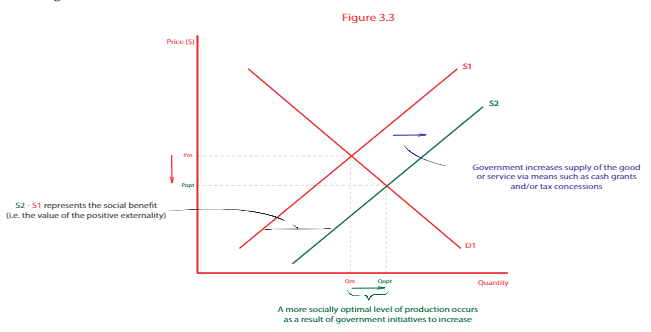
Positive externalised consumption
Increase the willingness of consumers to consume products causing positive externalities, by making conditions of demand more favourable (shift right).
social benefits increase,
relative price increases and causes suppliers to reallocate their resources into producing the product and
quantity available in the market increases.
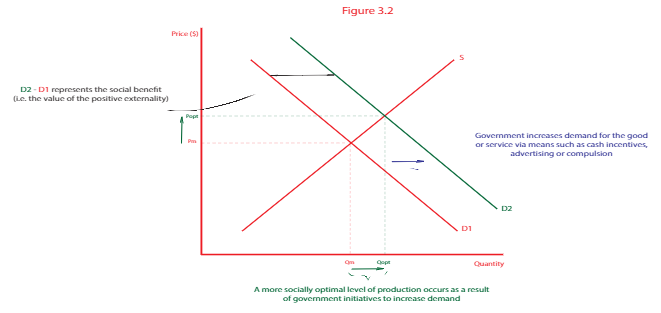
Government intervention: Positive Externalities
Gov Regulation
Laws that can ban production or consumption of certain activities
Impose requirements on producers or consumers if they want to engage in certain activities
Advertising
Create ads to promote consumption of g/s and reduce the degree of ignorance about the potential benefits by providing meaningful information
Subsidies and direct provision
Subsidies private costs by granting tax relief
The gov does not “subsides advertising”
What are Negative externalities?
Occurs when the production activities undertaken by suppliers impose costs on society/third parties.
Reduced living standards
Social costs > private costs
Private benefits > social benefit
Overallocation of resources
When the firm decides how much of a good to produce they will not consider the costs to society because they can externalise those costs onto a third party (not have to pay for it)
Negative externalities in production graphed
Decrease the willingness and ability of producers to produce products causing negative externalities, by making conditions of suppliers less favourable.
What are negative externalities in consumption
Occur when the consumption of goods and services impose external costs on third parties
The benefit from private consumption is larger than the social benefits from the same activity (i.e. the rest of society experience a decrease in their living standards).
This results in an over allocation of resources to the production and consumption of the good in question (as the price will not account for the social costs and hence the price will be lower —> mean more consumption —> more produced)
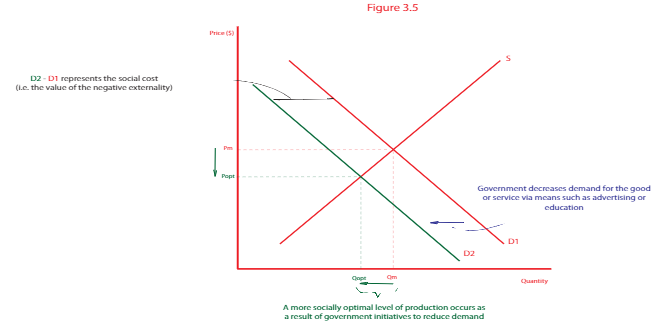
Government Intervention: Negative externalities - Gov regulations
Law that can ban certain production or consumption activities or imposes requirements on producers or consumers if they want to engage in certain activities
e.g.) In 2007, the Victorian Government banned the smoking of cigarettes in any enclosed public environment, helping to reduce the negative externalities associated with passive smoking
Government Intervention: Negative externalities - Indirect taxation
Source of revenue for the gov, where the tax may be imposed on a producer but where the consumer will ultimately pay for most of it
e.g.) Luxury car tax
Government Intervention: Negative externalities - Subsidies
Providing subsidies to the production of goods and services that cause fewer negative externalities.
Works with indirect tax and acts to speed to substitution
Government Intervention: Negative externalities - Advertising
Influences the taste and preferences
Educate the public
e.g.) QUIT campaigns
What is a demerit good and how is it different to a negative externality?
Demerit goods are those that are considered harmful or ‘bad’ for the person consuming them.
Goods with negative externalities in consumption require third parties to be negatively affected.
This is not the case for de-merit goods
Government Intervention: Negative externalities - Gov regulations
Law that can ban certain production or consumption activities or imposes requirements on producers or consumers if they want to engage in certain activities
e.g.) In 2007, the Victorian Government banned the smoking of cigarettes in any enclosed public environment, helping to reduce the negative externalities associated with passive smoking
Government Intervention: Negative externalities - Indirect taxation
Source of revenue for the gov, where the tax may be imposed on a producer but where the consumer will ultimately pay for most of it
e.g.) Luxury car tax
Government Intervention: Negative externalities - Subsidies
Providing subsidies to the production of goods and services that cause fewer negative externalities.
Works with indirect tax and acts to speed to substitution
Government Intervention: Negative externalities - Advertising
Influences the taste and preferences
Educate the public
e.g.) QUIT campaigns
What is Asymmetrical Information?
Is a situation where one party has more information than the other in a transaction which prevents rational and efficient decisions to be made about resource allocation.
Seller > buyer → 2nd hand cars
Seller < buyer → Insurance
What is Moral Hazard
Occurs when economic agents adjust their behaviors in ways that are less efficient or unfavorable from society’s point of view
Reflects the fact that people may change their behavior once a transaction has already taken place
E.g.) Those who know they have car insurance may not take measures to reduce theft as they know they will be reimbursed in the case of loss.
E.g.) New worker may start to slack off after probation period has ended
Due to Asymmetric info
Government Intervention: Asymmetric Information - Gov regulations
Protect consumers from misinformation that might be provided by sellers —> Australian Consumer Law makes it illegal for firms to engage in conduct that misleads or deceives consumers or other businesses
Food labelling laws
Government Intervention: Asymmetric Information - Advertising
Consumers are unaware of benefits associated with merit goods hence,
Merit goods tend to be underprovided in a free market and demerit goods may be overprovided, which in part is caused due to a lack of knowledge
e.g.) The government could run information campaigns that highlight the benefits associated with purchasing fresh food and vegetables
The government could inform the public about what smoking, drinking and excessive consumption of the wrong types of foods could do to their health
Government Intervention: Asymmetric Information - Subsidies
Subsidies firms who provide meaningful information for consumers
e.g.) Documentary makers, who highlight the health consequences associated with the consumption of merit and demerit goods may be able to receive grants from the government, which increases the likelihood that potential consumers have access to meaningful information
What are Common Access resources?
Are resources that are both non-excludable and rivalrous.
As these products are non-excludable (you can’t force people to pay for them), but rivalrous (meaning they will deplete if used), they appear to be seemingly free to users, therefore the market does not send proper price signals and the resources tend to get overused.
(e.g. fish)
How do common access resources cause market failure?
TALK ABOUT INTERTEMPORAL EFF
The overuse of common access resources by current generations reduces the amount that is available for future generations, resulting in lower living standards.
The negative externality is the cost imposed on a third party, which in this case, is all future users of the common access resource.
What is the Tragedy of the Commons
Where everyone has the incentive to use a common access resource but nobody has or takes individual incentive to manage and sustain it
Government Intervention: Common Access Resources - Gov, regulations
Requirements that cars be fitted with catalytic converters because excess pollution reduces the amount of clean air (a common access resources) that is available.
CFCs have been banned as they created a hole in the ozone layer (common access resource) because it provides protection to all from harmful UV rays.
International Agreements (Kyoto protocol)
Government Intervention: Common Access Resources - Indirect Taxation
The climate is a CAR and human activity causes climate instability and the warming of the planet
Gov attempts to mitigate the effects of climate change through the introduction of a carbon tax —> made fossil fuels more expensive —> consumers need to pay more —> less demand
Government Intervention: Common Access Resources - Subsidies/ Direct Action
Subsidise the cost of solar panels
Reduce the tax payable on electric vehicles
Direct Action
This alters relative prices and encourages consumers to move towards products that do less damage to common access resources.
What is Government Failure?
A situation where government intervention fails to improve the allocation of resources or, in some cases, actually makes the allocation of resources less efficient when compared to the free market outcome.
The difficulty governments face as they seek to correct market failure is that the external costs or benefits are hard to measure
What is the ‘true cost’ of using fossil fuels
What is a Price Ceiling? (MF)
An attempt by the gov. to control prices
Where the sellers of the goods or services are banned from raising their prices above a certain level.
AIM: Make products affordable for low-income groups
BAD:
Shortage
Black markets open (up the price - risk)
Decrease in imported goods as the “fair price” is below the cost for the supermarket to import the item
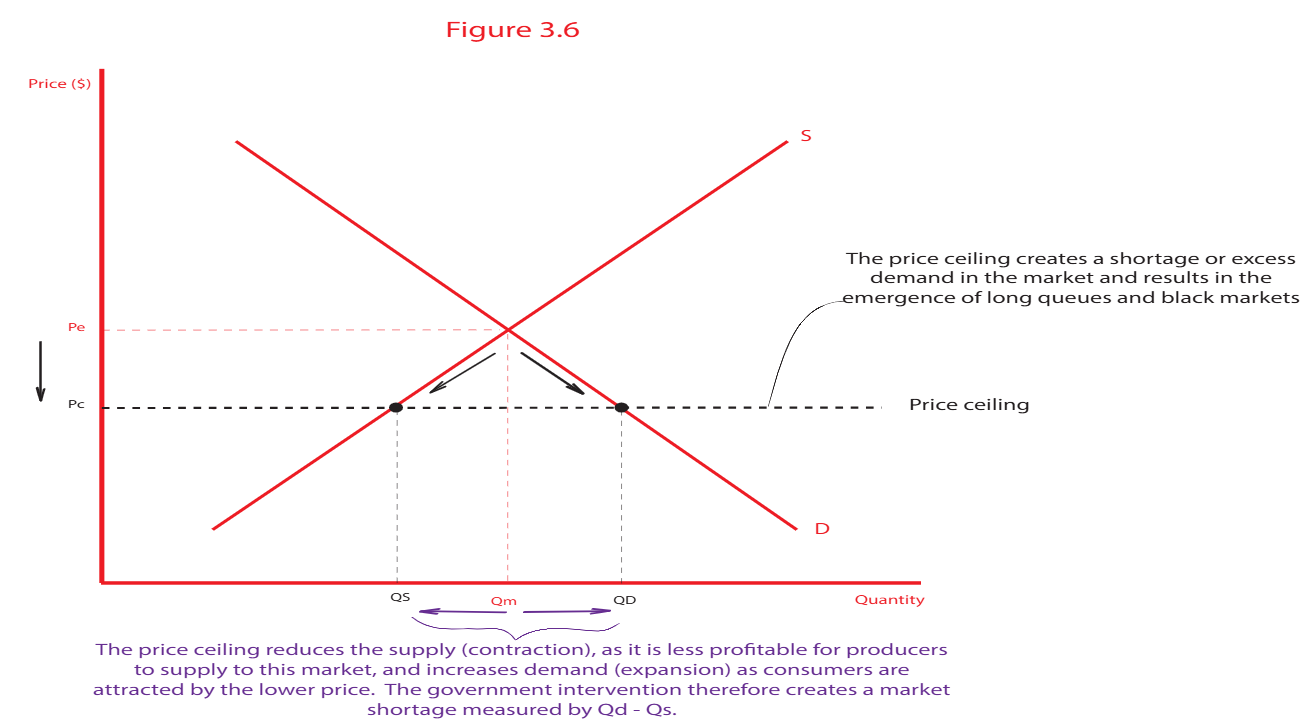
What is Price Floor? (MF)
An attempt by the gov. to control prices
Where the price offered in the market cannot go below a certain level.
AIM: protect the incomes of those selling the product (such as farmers, whose incomes can be quite unstable due the low PED and PES of the products they sell)
BAD:
Significant waste (due to surplus)
Harder for businesses to compete with international firms as it is difficult to keep their prices lower (e.g. minimum wages)
How to remember where the Price Floor and Price Ceiling are in the D/S graph?
Any artificially set price ceiling will always be below the market equilibrium price, and the price floor will always be above the market equilibrium price.
‘the floor is on the ceiling and the ceiling is on the floor’
What is the difference between the cash rate and the exchange rate?
Cash rate:
The cash rate is a domestic monetary policy instrument, that targets interest rate set by the Reserve Bank of Australia (RBA)
Exchange rate:
The exchange rate represents the value of the Australian dollar in relation to other currencies and is predominantly determined by market forces in the foreign exchange market
MLS and NMLS
MLS: Refers to the access of physical things we have which improve our economic wellbeing.
E.g. money in the bank, a house, car, laptop, a ridiculously large TV.
Refers to access to G/S
NMLS: Refer to the non-tangible aspect of life that impact on our overall quality of life.
E.g. crime rates, stress levels, leisure time, education rates, trust in government
The Business Cycle
Economics activity that takes place over an extended time frame
Refers to the wave-like ups and downs in a nation's level of production or economic activity.
The short- mid- term cyclical swings in economic activity ← Affected by AD (short - term)
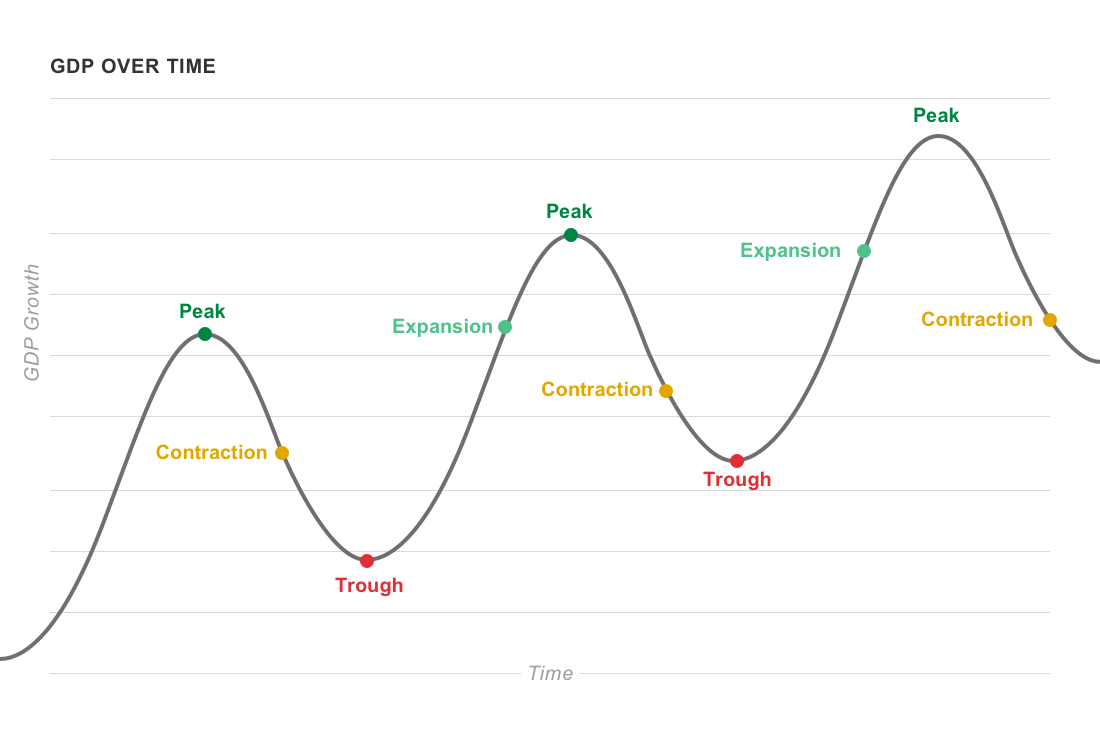
What happens when the business cycle meets the dotted line?
When the graph meets the dotted line (the average growth trend) we are at domestic economic stability.
Expansion/ Recovery Phase
Signalled by rising GDP growth
falling unemployment ← Increased derived demand
inflation gradually rises. ← close to productive capacity
The Peak/ Boom Phase
Unemployment reaches its lowest level
inflation is a high
GDP is high - high economic growth above the sustainable rate of economic growth. (3%>)
BC and CC is high → encourages spending → reduction in savings
Strong demand → more production → more labour
Leakages < injections
Shortages → inflation
Demand for borrowing increases (in order to spend more) → interest rates increase
Why is boom unlikely to last a long time?
Unsustainable due to the amount of resources the economy has access to and uses
Inflation will be too high —> purchasing power decreases —> demand decreases/ or gov intervenes
All the resources are used (at productive capacity)
The slowdown/ Contraction Phase
GDP slows, and in severe cases production falls. (severe production falls)
After a time lag, unemployment will rise
inflation eases.
More saving